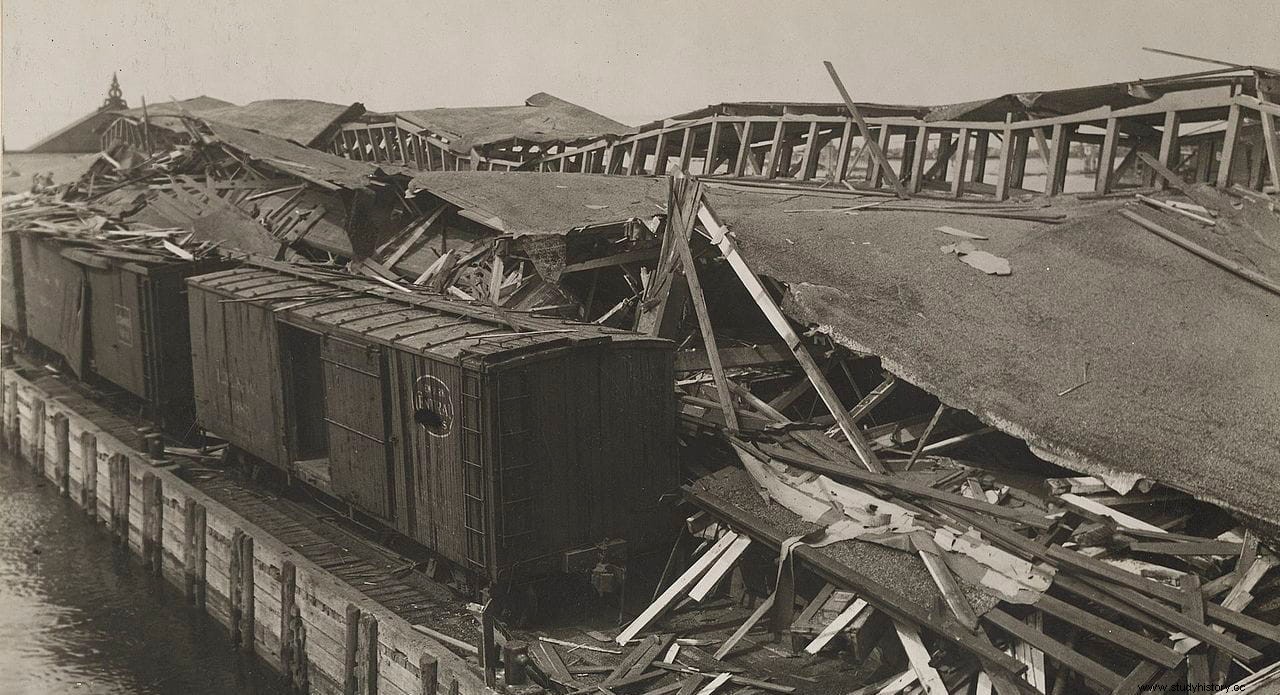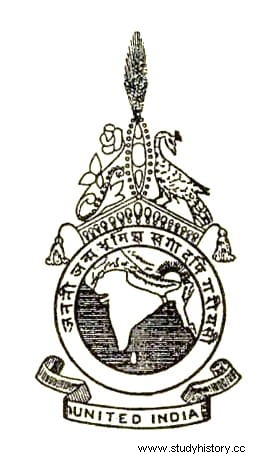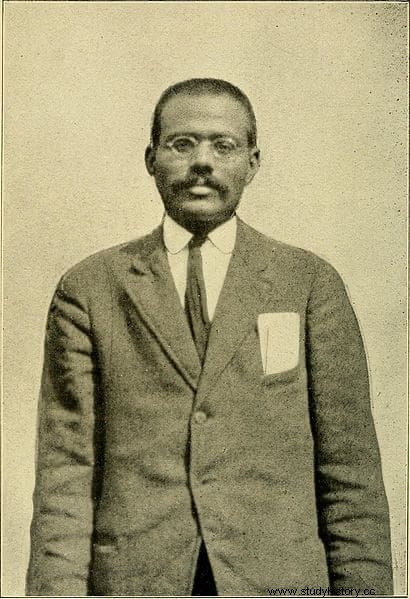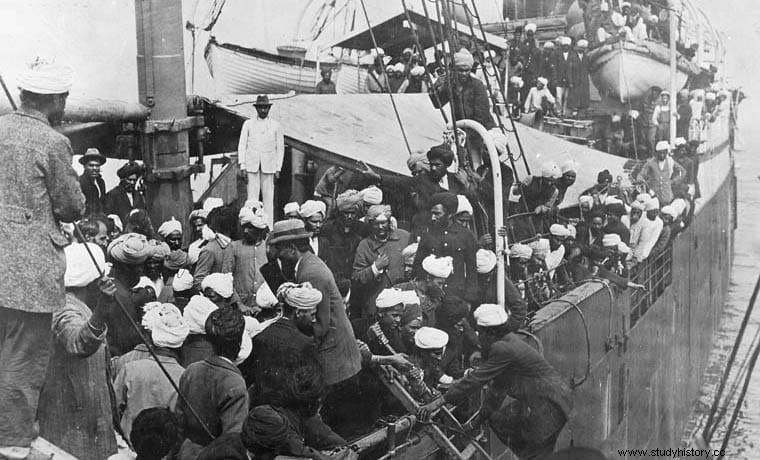On the night of July 30, 1916, the residents of New Jersey woke up to a thunderous detonation accompanied by a very violent shake:a thousand tons of ammunition stored in Black Tom had just exploded. , an artificial island located at the mouth of the Hudson River, very close to the Statue of Liberty, which also received such damage to its torch that it had to be replaced. Also, the stained glass windows of St. Patrick's Cathedral were shattered and the wall of City Hall cracked.
The worst thing was that seven people died and there were hundreds of wounded; Immigrants waiting on Ellis Island had to be evacuated as subsequent fires continued to cause minor outbreaks for hours.
Although two guards were initially accused of having lit some lanterns, the investigations soon pointed in a much more serious direction:it was an attack organized by German agents (the First World War was at its height) with the collaboration of two nationalist groups, one Irish (Clan na Gael ) and another Indian (Ghadar Party ), along with the support of some communist militants.

This case would soon be related to another that occurred the previous year, in which the same groups participated and which consisted of transporting weapons (2,400 Springfield carbines, 400 Hockoss rifles, 500 Colt revolvers, 250 Mauser pistols, and millions of cartridges) from the US to India to equip a rebellion against the British Raj. The ships where they were to be taken, called Maverick and Annie Larsen , were intercepted and the second gave its name to the subsequent process, which lasted until 1917 in what was the longest trial in American history.
Surely more than one is wondering why the Indians (from India, not Americans) got involved in that and the reason is known by several names:Indo-German Conspiracy, Hindu Conspiracy, Ghadar Conspiracy or even the German Plot to dry . They are not exact denominations because not all the participants were of the Hindu religion (Muslims and Sikhs were also involved), apart from the Irish and Turks. In any case, the collaboration between one and the other against those they considered common enemies is obvious, even though at the time of the aforementioned incidents, the US was still officially neutral.

The desire for greater autonomy, and even to completely shake off British domination, had been growing since the founding of the National Congress of India in 1885 and in some places, such as the Punjab and Bengal, it took on violent overtones, especially after the division of this last in 1905. This extremism was reflected in the creation of radical groups such as Jugantar or Anushilan Samiti , who promoted political assassinations and even threatened the Viceroy of India himself in 1912. The repression was harsh but unsuccessful and when the First World War broke out, new possibilities opened up for Indian activists.
The Germans goaded them into open rebellion, promising them arms and ammunition. Thus began to spread an exalted nationalism that opened offices in England (Casas de la India , they were called) taking advantage of the wide community of compatriots established there; but also in the USA, where they also contacted the Irish counterpart groups, learning organization, logistics and diverse advice from them. In America (basically on the West Coast and Canada) there was also a considerable Indian immigrant population, especially from the Punjab, and the marginalization to which they were subjected constituted a good breeding ground for expanding the idea and recruiting militants.
It was on the Pacific coast, especially in San Francisco, where this situation favored the founding of the Ghadar Party in 1913. It was led by Har Dayal and its president was Sohan Singh Bhakna; the first, Punjabi, had a somewhat mixed ideology in which he mixed atheism with Buddhism, pacifism with revolution and Marx with Bakunin. A good student, a fellow at Oxford, he traded his comfortable life for austerity and the cause. For his part, Sohan Singh Bhakna also came from the Punjab but emigrated to the US, where he worked in modest trades and felt betrayed by Canada's restrictive anti-immigrant legislation.
The Ghadar movement was born with the idea of kicking the British out of India by force, encouraging soldiers to revolt and promoting terrorist actions. Of course, London pressured Washington to put an end to these subversive activities, but with the outbreak of the world war, the so-called Berlin Committee was also formed in Germany, later renamed the Committee for the Independence of India, which received the support of the Foreign Ministry, which allowed mutual collaboration on American soil through the German consulate in San Francisco.

It was the German radio that in May 1914 publicly announced that the ship Komagata Maru , carrying four hundred Indian emigrants, was about to arrive in Vancouver. As they calculated, the Canadian government prevented his arrival and forced him to turn around, causing unrest in the Indian community; nothing compared to the riots that occurred when returning to the starting point, after the British authorities arrested them. The situation was deemed dangerous enough to send a force of fifteen thousand men to the Crown Jewel .
This contingent was due in part to the fact that the work of the Ghadar extended to the Asian colonies:Hong Kong, Canton, Shanghai... Also to Korea, China and Japan, where they tried to buy weapons on a large scale or, in the Chinese case, allow the transport of these to India through its territory in exchange for Teutonic military advice. Sun Yat Sen's refusal to join an alliance with the European country frustrated the operation. Then the most diverse plans followed one another, from attacking Lord Kitchener (with the help of Egyptian revolutionaries) or other leaders such as the Frenchman Poincaré or the Italian King Vittorio Emmanuel II (according to anarchists) to planting bombs in the port of Liverpool, attack the Lahore armory or incite a mutiny among the native troops.
All failed, some due to practical impossibility, others when discovered by the secret services. As we have seen, neither is the smuggling of weapons from the US in the Annie Larson it went right. However, some minor arms thefts were successful and a general uprising was projected for February 21, 1915:the horsemen of the Punjab Cavalry they were to kill their officers as a signal to start the rebellion, which would continue in Delhi, Lahore and Bengal. A leak ruined everything and several suspicious regiments were disbanded while a wave of arrests was unleashed. Even so, some bodies mutinied, such as the Fifth Light Infantry or various units from the Malay States, a total of some eight hundred and fifty soldiers who ended up executed or deported.

The attempts continued. In April 1915, another large arms shipment was prepared from the United States that included seven thousand three hundred Springfield carbines, almost two thousand pistols, ten Gatling guns and three million cartridges. The ship SS Djember It was supposed to take them to Surabaya (in present-day Indonesia) but again the counterintelligence did their job well, frustrating the operation. Meanwhile, in Bengal, the uprising planned by German agents for Christmas of that year failed, as not all these shipments arrived and there was a lack of means.
Not everything was reduced to the Indian subcontinent. In Afghanistan, there was an extension of the Great Game of the 19th century with Germany replacing Russia in the role of destabilizing the region to force Britain to divert troops there. The Indo-German weeds incited the Afghan tribes to rebel but there was no coordination and in mid-1916 the Germans had to throw in the towel (although they would still try to force the play in the following years, inviting the Soviets to a joint action that would not materialize either). ). The Indian attempts in Egypt and Mesopotamia were also unsuccessful because they were seen as mere Berlin puppets.
In any case, after the Annie Larsen affair, the arrests and dismantling of pro-Indian groups were unleashed, with trial after trial and thus suffocating the movement. The infiltrators introduced in the Ghadar ended up killing it in 1919 and although there were outbreaks again in the Second World War (we saw it in a glimpse in another article), we would have to wait for its end for decolonization to become a reality.
